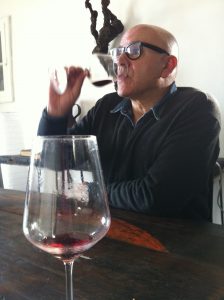I imagined that when she suggested that I visit today that she wouldn’t have a lot of time for me. Just as I arrived, an impromptu group of French buyers asked for a tasting: this quickly moved into a ‘drinking’, the group expecting hours of hospitality, way beyond industry standards, their Gaul-hobbled Italian, painful to follow, well before their second hour.
She didn’t even flinch.
As they packed back into their rental cars, Arianna and I walked her vineyard together, between the vines, the impossibly-fragrant yellow broom and wild spring flowers brushing up to our thighs as we strolled.
‘So how do YOU make peace with the fact that so much of your market is not Sicilian, or even Southern Italian’, I ask. She walks some more, uprooting a blousy-blossomed, fuschia wild flower: she examined its petals in silence, composing her thoughts.
‘There is no place I’d rather live’, she says. ‘To make wine at a higher level in Southern Italy dictates two things. Hard work. And lots of travel…..in Northern Italy, Northern Europe, America, and beyond.
‘And so you’ve always seen selling and marketing as part of the process of making wine? Seeing, as communicating with the outside world tends to be a profound cultural weakness here in the South’.
‘It never stops surprising me, how rich life is here, how little we are able to communicate this with the outside world’.
A few hours later, she puts her weight into the giant cellar door: it groans open, revealing pallets of wine, a tractor and stacks and stacks of empty bottles, ready to be filled, labeled and sent off to the four corners. It’s the human-scale- the hand-madeness- of wine making that always impresses me, that a label might be ever-so-slightly crooked on the bottle because the phone rang at that moment, or that the vineyard dog passed between one’s feet.
She hands me a corkscrew and I open a bottle of her frappato, a Sicilian grape that she almost single-handedly brought into fashion. Related to Calabria’s gaglioppo, it’s a cherry-flavoured red, light and fruity, almost zippy in the glass.
We taste through three vintages, her rinsing each glass with the first wine poured from the bottle. It occurs to me to remind her that it’s just me, that she doesn’t need to do the ceremony on my account. Then it strikes me that she isn’t, that this is how she balances her life, that this is what she likes to do, when she isn’t bouncing around on the tractor or collecting her luggage at 7am at the carousel in the airport in Copenhagen.
‘Lunch’, she announces, not as invitation but something closer to just telling the time.
I go to work on cutting the onions and lettuces, she fills a pot with water drawn from the stone sink. We sit down to lunch together,talking for hours about Southern Italy and the wine produced here, two well-traveled individuals, madly -almost painfully- in love with the very ground beneath our feet.
About Sicilia


La Sicilia is the largest island in the Mediterranean Sea and a semi-autonomous region of Italy, a nation famous for her profound regionalism, and virtual lack of nationalism. Sicilian wines are deeply influenced by the almost African heat and a culture borne of thousands of years of foreign invasions. Its western coast features wines with incredible salinity, the soil soaking up great amounts of salt reclaimed from the Mediterranean, the fruit of fierce winds and ever-present sun. The east coast produces saline and herby reds, zesty enough to make your mouth pool.








No comment yet, add your voice below!